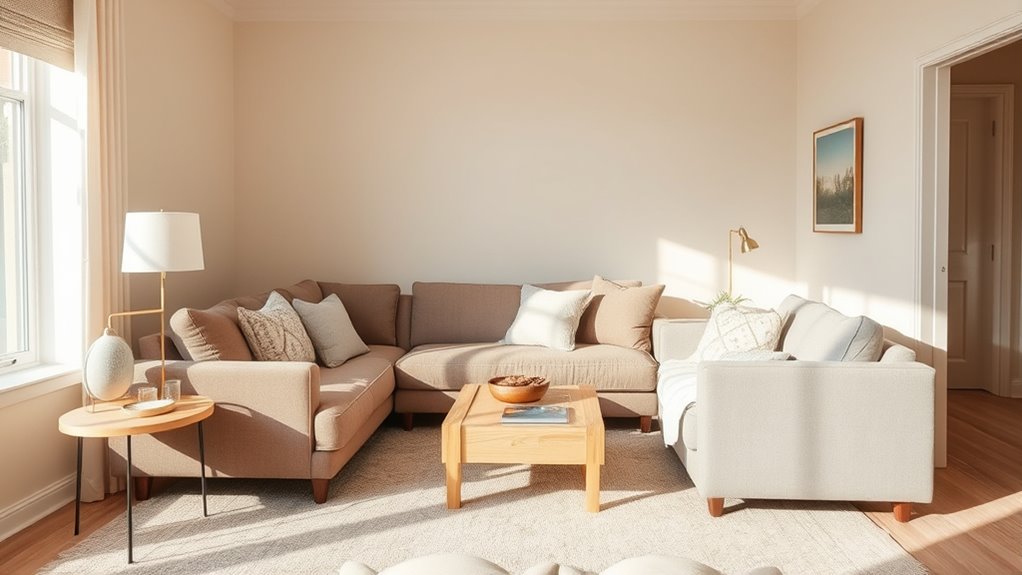Using warm neutrals like beige, taupe, and soft browns can make your small room feel bigger and more inviting. These shades reflect natural light, creating an open, airy atmosphere while adding coziness. Try selecting the right tones that suit your space and enhance brightness with smooth progressions or subtle color fades. Incorporate light furniture and decor accents to maintain a balanced, spacious feel. Keep exploring options to keep your space lively and comfortable.
Key Takeaways
- Use light, warm neutral shades like beige, taupe, and soft brown to reflect light and create an airy, spacious feel.
- Incorporate smooth color transitions and gradients to enhance light reflection and add depth without clutter.
- Select furniture in warm neutral tones with varied textures to foster coziness while maintaining an open atmosphere.
- Maximize natural light with sheer window treatments and strategic placement of reflective surfaces to amplify brightness.
- Layer textures and subtle accents in warm neutrals to add visual interest, depth, and dimension without overwhelming the space.
Understanding the Power of Warm Neutrals in Small Spaces
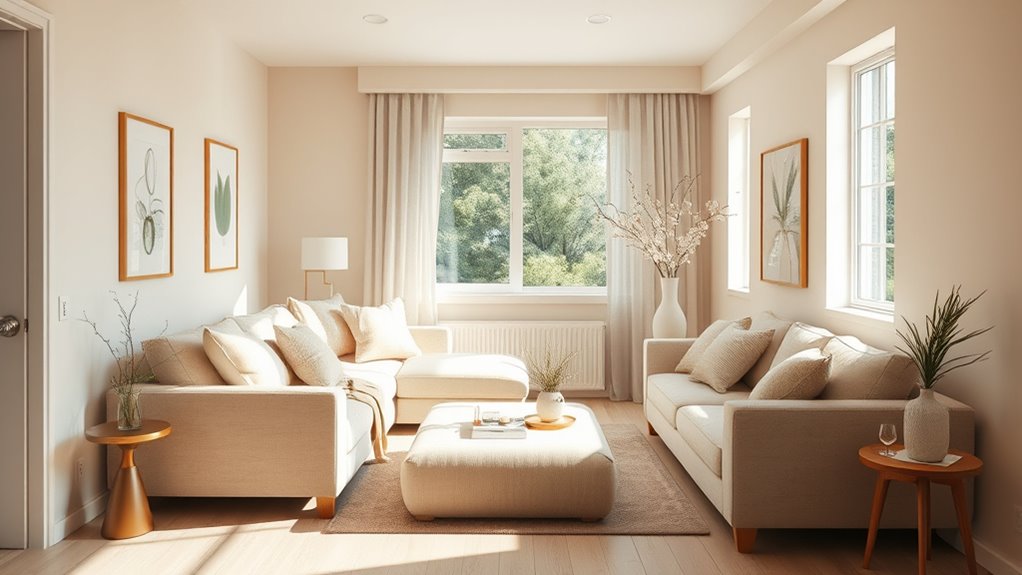
Warm neutrals are a powerful tool for making small rooms feel more spacious. Neutral color psychology shows that these shades create a calming, open atmosphere that visually expands a space. Warm neutral palettes, which include shades like beige, taupe, and soft browns, reflect light better and prevent rooms from feeling cramped. They also add warmth and comfort without overwhelming the senses. By choosing warm neutrals, you leverage their subtlety to avoid cluttered or busy appearances, helping your small space breathe. Proper color selection can enhance the perception of space and comfort in confined areas. These colors can serve as a versatile backdrop, making it easier to add decor without overwhelming the room. Ultimately, understanding how warm neutrals influence perception allows you to craft a more inviting, spacious environment in even the tiniest rooms.
Choosing the Right Warm Neutral Tones for Your Room
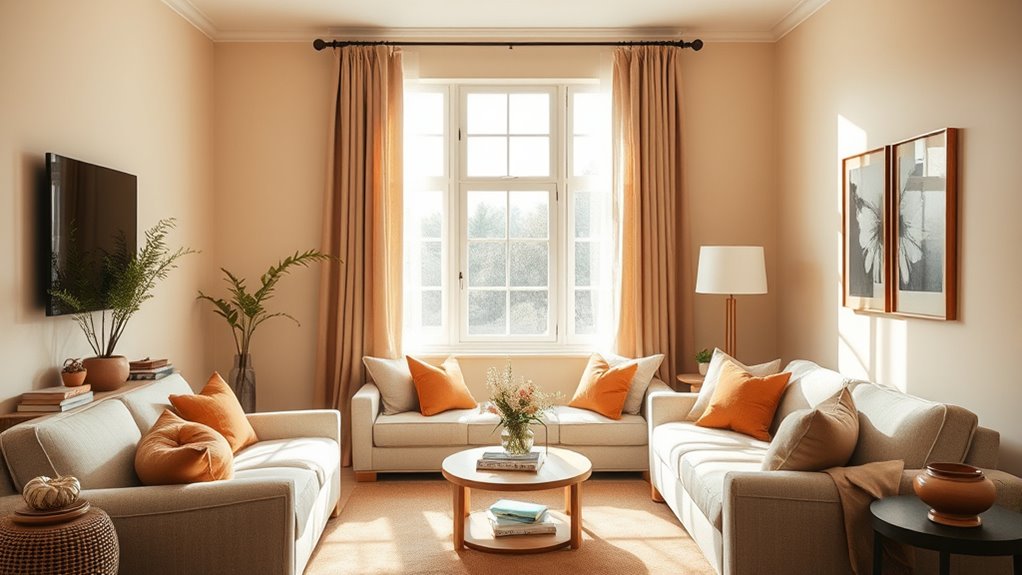
To choose the best warm neutral tones for your room, start by considering the natural light available, since it greatly influences how colors appear. Light enhances warm neutrals, making them feel airy and expansive, while less natural light may deepen their warmth or create shadows. Use color psychology to select shades that promote the mood you desire—soft beiges evoke calmness, while warm taupes add coziness. Staying current with interior design trends helps you pick versatile shades that won’t feel outdated, yet still feel fresh. Test samples in different lighting conditions to see how they transform throughout the day. Incorporating seasonal color palettes can also help you select shades that align with current trends and enhance your space’s ambiance. Ultimately, your choice should complement your space’s natural light and reflect your personal style, making your small room feel more open and inviting.
Painting Techniques to Maximize Light and Space

To make your small room feel more open, focus on light reflection strategies like using semi-gloss or satin finishes that bounce light around. Smooth color progressions, such as subtle gradients or carefully blended edges, also help create a seamless sense of space. These techniques work together to maximize natural light and enhance the room’s spacious feel. Incorporating essential oils for respiratory health can also promote a more relaxing environment, making the space feel even more open and inviting.
Light Reflection Strategies
By selecting light-reflective paint techniques, you can effectively amplify natural light and artificial illumination in small rooms. Using high-gloss or semi-gloss finishes on walls creates reflective surfaces that bounce light around the space, making it feel larger and brighter. Positioning reflective surfaces, like mirrors or metallic accents, opposite windows enhances natural light, maximizing its impact. Light colors, especially warm neutrals, also help reflect more light, reducing shadows and dark corners. Avoid dull, matte finishes in areas where you want to boost brightness, as they absorb rather than reflect light. Combining these strategies ensures your small room feels more open and airy, creating a welcoming atmosphere with minimal effort. The right paint and surface choices play an essential role in expanding your space visually. Incorporating expert voice actors or engaging soundscapes in visual presentations can further enhance the perception of openness and vibrancy in your decor.
Color Transition Techniques
Changing between colors thoughtfully can dramatically enhance the sense of space in a small room. Utilizing color fading creates seamless progressions, making walls appear longer and more expansive. Start with a darker, warm neutral at the base and gradually lighten as you move upward or across the wall. This tonal harmony reduces harsh boundaries, giving the illusion of depth. By blending colors smoothly, you avoid abrupt shifts that can make a space feel smaller or disjointed. Techniques like ombré or subtle gradient effects emphasize light reflection and create a cohesive flow. These progressions draw the eye inward, making your room feel larger and more open. Thoughtful color fading and tonal harmony are powerful tools to optimize space without overwhelming your small room’s natural warmth. Additionally, incorporating color tuning principles can help you select the most effective shades for your space.
Incorporating Warm Neutrals Through Furniture and Decor
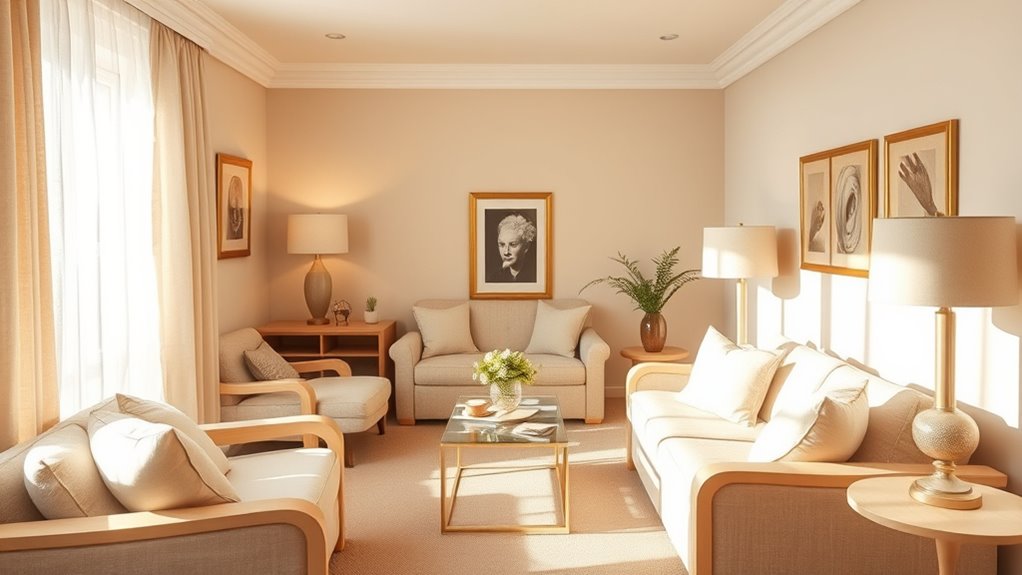
To make your small room feel more spacious, choose warm neutral tones for your furniture and decor. Mixing different textures and materials adds depth without overwhelming the space. Be sure to balance your decor elements so the room feels cohesive and inviting.
Selecting Warm Neutral Tones
Selecting warm neutral tones for your furniture and decor can instantly create a cozy, inviting atmosphere in small rooms. When choosing these hues, consider their influence through color psychology, which shows they promote calmness and warmth. Historically, warm neutrals have been used to evoke comfort and timeless elegance in interior design. To effectively incorporate these tones, keep in mind:
- Opt for shades like beige, warm taupe, or soft caramel to maintain light flow.
- Use furniture with warm wood finishes to add natural richness.
- Add decor accents like cushions or rugs in muted terracotta or amber to enhance depth.
- Incorporating warm neutrals in your design can also help in making the space appear larger and more open.
Mixing Textures and Materials
Incorporating warm neutrals through a mix of textures and materials adds depth and interest to small rooms. Textural layering creates visual complexity, making a space feel richer without overwhelming it. Combine smooth surfaces like matte finish furniture with tactile elements such as woven rugs or velvet cushions to enhance warmth. Material contrast, like pairing wood with metal or linen with leather, emphasizes different elements and guides the eye around the room. Use these variations thoughtfully to avoid clutter and maintain a cohesive look. Opt for warm neutral tones across diverse textures to unify the space, while contrasting materials add dimension. Incorporating vetted product reviews can help you select quality decor items that complement your design. This approach guarantees your small room feels inviting and expansive, with an engaging visual balance that complements your overall design.
Balancing Decor Elements
Balancing decor elements with warm neutrals creates a harmonious and inviting small room. To achieve decor harmony and maintain visual balance, carefully select furniture and decor accents.
- Choose furniture in warm neutral tones that complement your walls, avoiding overwhelming contrasts.
- Incorporate accent pieces, like pillows or artwork, that add subtle pops of color without disrupting the overall calm.
- Use layering with varied textures and materials to deepen the space’s visual interest while keeping the palette cohesive.
Balancing Warm Neutrals With Accents for Visual Interest

While warm neutrals create a cozy and inviting atmosphere in small rooms, adding well-chosen accents prevents the space from feeling monotonous or dull. An accent wall in a slightly bolder shade can break up the neutral palette and add visual interest without overwhelming the room. Consider artwork placement that complements the warm tones; strategically hung pieces draw the eye and create focal points. Use contrasting textures or subtle pops of color in accessories like pillows, rugs, or vases to enhance the neutral base. Incorporating diverse design options such as quirky shapes or textured elements can further elevate the space’s visual appeal. These accents should balance harmoniously, providing variety while maintaining the room’s airy feel. By thoughtfully selecting accent elements, you make the space lively and engaging, all while preserving the warm, spacious ambiance you aim for.
Creating Depth and Dimension With Warm Neutral Shades
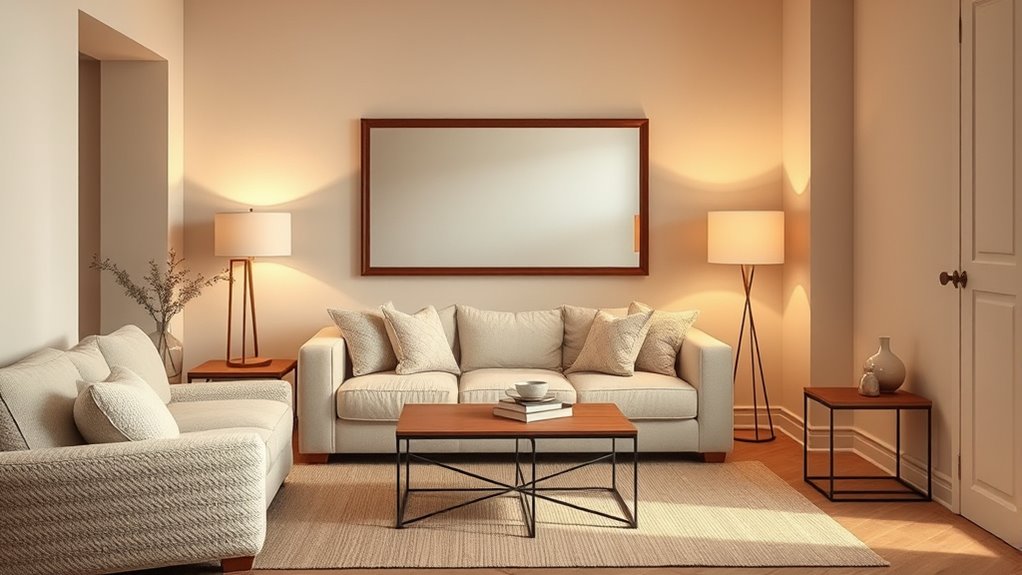
Adding depth and dimension to small rooms with warm neutral shades involves more than just choosing the right colors; it’s about creating visual layers that draw the eye in and make the space feel larger. You can achieve this by layering textures, which adds tactile interest and prevents the room from feeling flat. Incorporate contrasting shades within your warm neutrals—darker and lighter tones—to create subtle depth and highlight architectural features. Consider these strategies:
- Use textured fabrics like linen or woven rugs to add tactile layers.
- Introduce contrasting shades through accessories or artwork for visual interest.
- Vary wall finishes or paint techniques to enhance depth without overwhelming the space.
- Pay attention to color temperature adjustments to optimize the overall ambiance and perception of space.
These techniques work together to make your small room feel more expansive and inviting.
Tips for Maintaining a Bright and Open Feel in Small Rooms
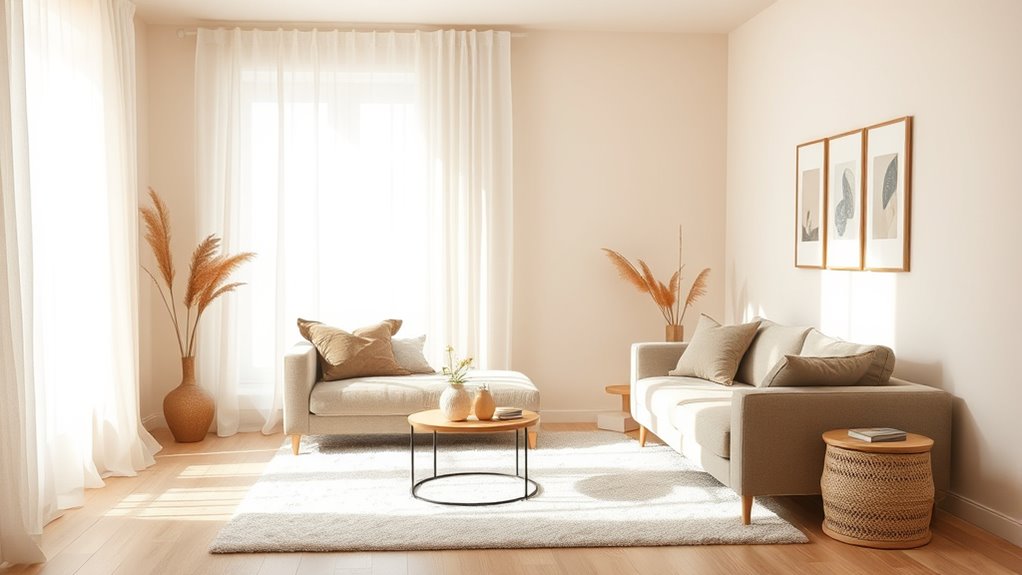
To keep small rooms feeling bright and open, focus on maximizing natural light and minimizing clutter. Use light-colored window treatments like sheer curtains or blinds that can be easily opened to let in sunlight. Keep windows unobstructed to enhance brightness throughout the day. Supplement natural light with well-placed artificial lighting, such as wall sconces or floor lamps, to create a warm, inviting atmosphere without overwhelming the space. Opt for lighting fixtures that emit a soft, diffuse glow to avoid harsh shadows. Regularly declutter surfaces and keep furniture streamlined to prevent visual congestion. These strategies work together to maintain a luminous, airy feel, making your small room appear larger and more welcoming at all times.
Frequently Asked Questions
How Can Lighting Enhance the Effect of Warm Neutrals in Small Rooms?
Lighting plays a key role in enhancing warm neutrals in small rooms. You should incorporate layered lighting—use ambient, task, and accent lights—to create depth and warmth. Reflective surfaces like mirrors and glossy finishes bounce light around, making the space feel larger. By thoughtfully combining layered lighting with reflective elements, you can maximize the cozy yet expansive feel of warm neutrals in your small room.
Are There Specific Warm Neutral Colors to Avoid in Tiny Spaces?
Imagine walking into a tiny room painted in dark shades or overly muted tones—it’s like a cave, not a cozy retreat. You should avoid these warm neutrals because they can make small spaces feel even smaller and more cramped. Instead, opt for lighter, brighter shades that reflect light and open up the room. Steer clear of overly muted tones, which tend to absorb light and diminish your space’s perceived size.
Can Warm Neutrals Be Used Effectively in Rooms With Limited Natural Light?
In rooms with limited natural light, warm neutrals can still work if you consider artificial lighting and color layering. You should use warm neutrals that reflect light well and add layered textures to create depth. Incorporate different light sources, like lamps and warm LEDs, to brighten the space. This combination prevents the room from feeling dull and helps the warm neutrals enhance the overall brightness and cozy atmosphere.
What Are Common Mistakes When Decorating Small Rooms With Warm Neutrals?
Ever wonder what trips you up when decorating small rooms with warm neutrals? A common mistake is neglecting color coordination, making the space feel chaotic instead of cohesive. Another is poor furniture placement—blocking light or creating clutter. To avoid these pitfalls, choose harmonious shades and arrange furniture to maximize openness. Be mindful, and you’ll transform your small room into a warm, inviting haven rather than a cramped space.
How Do Warm Neutrals Affect the Perceived Temperature of a Space?
Warm neutrals influence the perceived warmth of a space by creating a cozy, inviting atmosphere. When you use these tones, you enhance psychological comfort, making the room feel more welcoming. They can make a room seem warmer, even if the actual temperature stays the same, because these shades trigger a sense of relaxation and safety. So, your choice of warm neutrals can subtly boost the perceived warmth and comfort of any room.
Conclusion
By embracing warm neutrals, you’ll transform your small room into a cozy yet spacious haven—like a secret garden hidden behind castle walls. Choose the right shades, use clever painting techniques, and add thoughtful decor to keep things bright and inviting. Remember, even in this modern age of sleek gadgets, a well-balanced warm neutral palette can make your space feel larger and more welcoming. So go ahead, channel your inner Renaissance artist and craft a room that feels both timeless and open.
